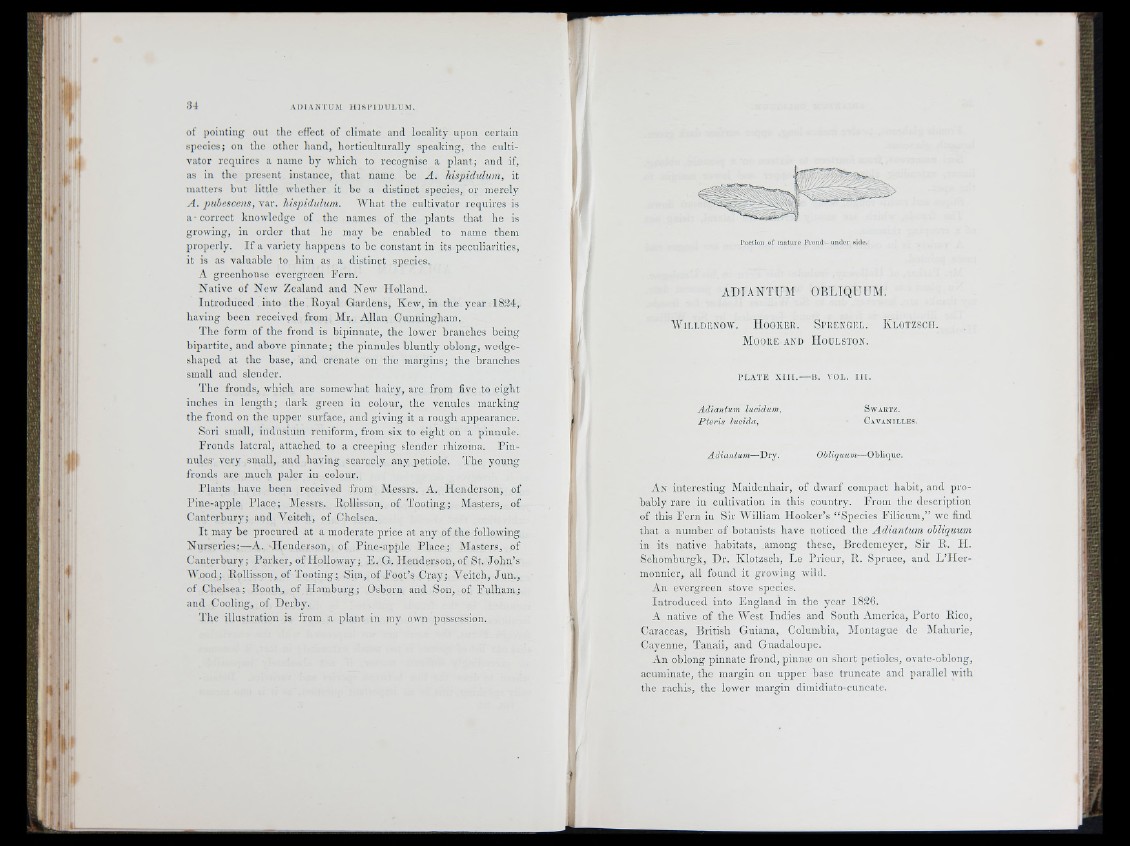
of pointing out tlie oHect of climate and locality upon certain
species; on tlic other hand, horticu ltu ra lly speaking, the cu ltivator
requ ire s a name by Avhich to recognise a p lan t; and if,
as in the p re sen t instance, th a t name be A . liispidulum, it
matters b u t little Avhcthcr it be a distinct species, or merely
A . jmbcscens, var. hispidiili/m. M'hat the cultivator requires is
a -c o r re c t knowledge of the names of the plants th a t he is
groAving, in order th a t he may be enabled to name them
properly. I f a variety happens to be constant in its peculiarities,
it is as valuable to him as a distinct species.
\ greenhouse evergreen Fern.
Native of New Zealand and New Holland.
In tro d u c ed into the Royal Gardens, Kew, in the year 1824,
having been received from i l r . Allan Cunningham.
The form of the frond is hipinnate, the loAvcr branches being
b ip a rtite , and above p in n a te ; the pinnules b lu n tly oblong, Avcdge-
shaped at the base, and crcnate on the margins; the branches
small and slender.
The fronds, Avhich are somewhat h a iry , are from five to eight
inches in le n g th ; dark g reen in colour, the venules marking
the frond on the u p p e r surface, and giving it a rough appearance.
Sori small, indusium rcniform, from six to eig h t on a pinnule.
F ro n d s lateral, attached to a creeping slender rhizoma. P in nules
very small, and having scarcely any petiole. T h e young
fronds are much paler in colour.
Plants have been received from Messrs. A. Hen d e rso n , of
P ine-apple P la c e ; Jle ssrs . Rollisson, of T ootin g ; Masters, of
Can te rb u ry ; and Veitch, of Chelsea.
I t may be p rocured at a moderate price at any of the folloAving
N u rse rie s:—A. H en d e rso n , of P ine-apple P la c e ; Ma sters, of
C a n te rb u ry ; P a rk e r, of IIolloAvay; F . G. H en d e rso n , of St. Jo h n ’s
Wood; Rollisson, of T ootin g ; Sim, of Foot’s C ray ; Veitch, Ju n .,
of Chelsea; Booth, of H am b u rg ; Osborn and Son, of F u lh am ;
and Cooling, of Derby.
T h e illustration is from a plant in my own possession.
I’ortioii of raatuve i-Tond- undur side.
ADI.-VNTUiM OBLIQUUM.
WiM.DENOW. H ooker. Si'rengf.l . K lotzsch.
M ooue and H oulston.
P L A T E X I I I . — Ii. A O ],. I I I .
A d ia n ium lucidum,
P t e r i s lucid a ,
A d ia n tum —'Dr^u
S w a r t z .
C.AVANILLES.
Obliquum— Obliquo.
A x interesting Ma idenhair, of dwarf compact h abit, and pro bably
rave in cultivation in this country. From the description
of this F e rn in Sir Mhlliam H o o k e r’s “ Species F ilicum ,” avc find
that a number of botanists have noticed the A d ia n tum obliquum
in its native habitats, among these, Bredcmeyer, Sir R. I I.
Schomburgk, D r. Klotzsch, Le P ric u r, R. Spruce, and L ’H e r-
monnier, all found it growing Avikl.
An evergreen stove species.
In tro d u c ed into E ng lan d in the year 182G.
A native of the West Indies and South America, Porto Rico,
Caraccas, B ritish Guiana, Columbia, Montague de Mahurie,
Cayenne, Tarraii, and Guadaloupe.
An oblong pinirate frond, pinme on short petioles, ovatc-ohlong,
acuirrinate, the margin on u p p e r base truncate and parallel with
the rachis, the loAver inargirr dimidiato-cuneate.